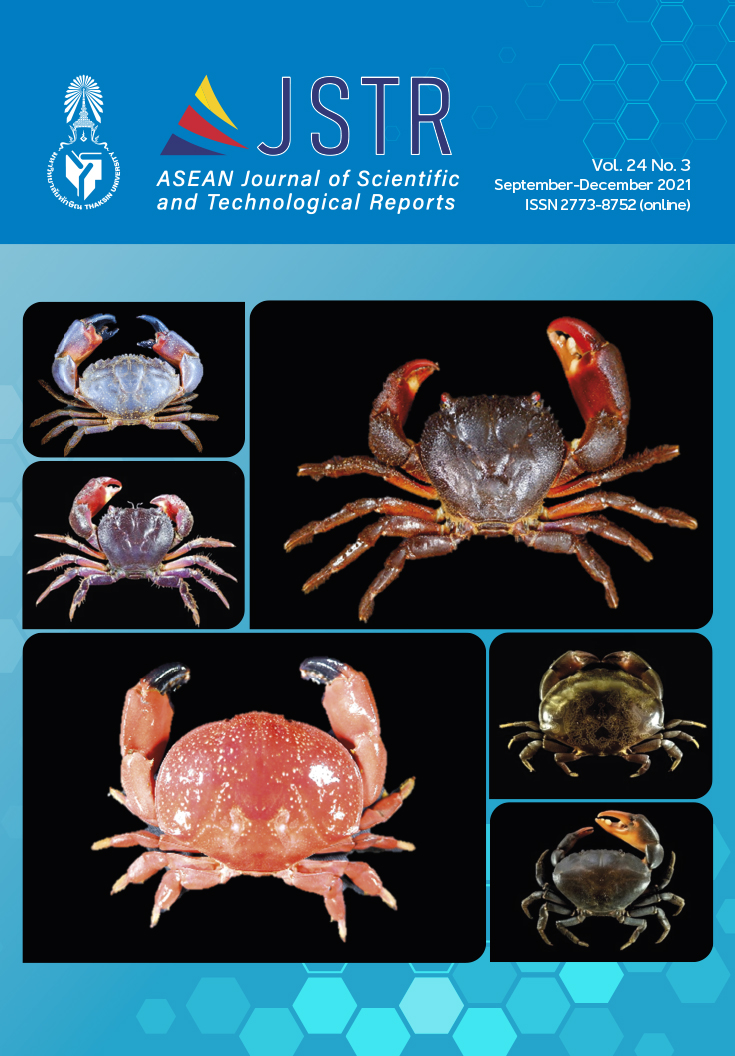Risk of Climate Variability on Tilapia Cage Culture in Songkhram River in Northeastern Thailand
Main Article Content
Abstract
The cage culture of Nile Tilapia in the river is one of the most important methods for Nile Tilapia (Oreochromis niloticus) farming in Thailand. Songkhram river is a significant river in north-eastern Thailand where Nile Tilapia river-based cage culture has been applied widely. However, river-based cage culture is an open culturing system where farmers do not fully control weather and water quality. This study investigates the risks of climate variability on Nile Tilapia in riv-er-based cage culture. This study recommends strategies to reduce fish yield losses. The samples of this study are the Nile Tilapia river-based cage culture farmers along the Songkhram river in 5 districts in Sakon Nakhon and Nakhon Phanom, including Thauthen, Khamtakla, Akatamnuai, Sisongkhram and Nathom. This study applies a simple random sampling method. We used structured questionnaires to collect the data from 148 fish farmers between April and December 2017. Hot weather during March and April was perceived to be the most important factor causing fish diseases and led to losses (68.2 %). The other significant factors that led to fish death were drought (52.7 %) and flood (40.5 %). Flood typically takes place between June and August. Cold weather was perceived not to affect the fish losses (32.4 %). However, it did affect the growth rate. Cold weather typically takes place between December and February. Re-garding the hot weather, fish farmers applied preventive measures such as mon-itoring and surveillance, stopping or delaying stocking schedules. For drought, the fish farmers relocated the cages towards the deeper water areas and used aerators to control water quality. Most farmers tie their cages securely during flooding season and relocate them closer to the bank. The fish farmers moni-tored their cages more closely than usual for the cold weather and postponed the stocking date. The study of risks and loss mitigation from climate variabilities in this research will be helpful for strategic aquaculture planning to cope with cli-mate variabilities in the future.
Article Details

This work is licensed under a Creative Commons Attribution-NonCommercial-NoDerivatives 4.0 International License.
References
FAO, Food and Agriculture Organization of the United Nations. State of the world Fisheries and Aquaculture in 2012, 1st ed.; FAO Fisheries and Aquaculture Department: Rome, Italy, 2012; 230.
Department of Fisheries. Fisheries Statistics of Thailand 2017, Fisheries Development Policy and Strategy Di-vision, Department of Fisheries: Bangkok, 2019; 92. [in Thai]
Sriphairoj, K.; Kamolrat, N.; Chaimongkon, W; Ingsrisawang, V. Cost-Benefit Production of Nile Tilapia Cage Culture in Sakon Nakhon province. Khon Kaen Agriculture Journal 2015, 43(Suppl 1), 588-594. [in Thai]
Sriyasak, P.; Whangchai, N.; Chitmanat, C.; Promya, J.; Lebel, L. Impacts of Climate and Season on Water Quality in Aquaculture Ponds. KKU Research Journal. 2014, 19(5), 743-751. [in Thai]
Belton, B.; Turongruang, D.; Bhujel, R.; Little, D.C. 2009. The history, status, and future prospects of mono-sex tilapia culture in Thailand. Aquac. Asia. 2009, 14(2), 16-19.
www.fisheries.go.th. https://www.fisheries.go.th/strategy/fisheconomic/Doc/.pdf (21 September 2019). [in Thai]
www.fisheries.go.th. https://www.fisheries.go.th/strategy/fisheconomic/pdf/.pdf (21 September 2019). [in Thai]
Yamane, T. Statistics: An Introductory Analysis, 2nd ed.; John Weatherhill Inc: Tokyo, 1970; 919.
Sakonnakhon provincial meteorological office. Data of air temperature and amount of rainfall in Sa-konnakhon in 2017. Sakonnakhon provincial meteorological office. 2017. [in Thai] ตรวจสอบการเขียนรูปแบบเอกสารอ้างอิง
Nakhonphanom provincial meteorological office. Data of air temperature and amount of rainfall in Na-khonphanom in 2017, Nakhonphanom provincial meteorological office. 2017. [in Thai]
De Silva, S.S.; Soto, D. Climate change and aquaculture: potential impacts, adaptation and mitigation. In Climate change implications for fisheries and aquaculture, ed.; Cochrane, K., De Young, C., Soto, D., Bahri, T. Eds; FAO: Rome, Italy, 2009; 151-212.
www.tmd.go.th. https://www.tmd.go.th/programs/uploads/intranet/docs/ncct-0008.pdf (10 August 2019). [in Thai]
Sanitwong Na Ayutthaya, A. Thailand’s First Assessment Report on Climate Change 2011: Impacts, Vul-nerability and Adaptation, In The Thailand Research Fund’s Research Development and Co-ordination Center for Global Warming and Climate Change (THAI-GLOB), Sanitwong Na Ayutthaya, A., Chidtaisong, A., Eds. THAI-GLOB: Bangkok, 2011, 206. [in Thai]
Sithicheevapak, K. Variation and Climate Change 2007, Climatological Center, Thai Meteorological De-partment, Bangkok. 2008. [in Thai]
Chidtaisong, A. Thailand Climate Change Volume 1: Past Climate, In The Thailand Research Fund’s Research Development and Co-ordination Center for Global Warming and Climate Change (THAI-GLOB), Sanitwong Na Ayutthaya, A., Chidtaisong, A., Eds. THAI-GLOB: Bangkok, 2010, 94. [in Thai]
www.fao.org. http://www.fao.org/docrep/field/003/AC171E/AC171E00.HTM (1 July 2018)
Lim, C.E.; Webster, C.D. Tilapia: Biology, Culture and Nutrition, 1st ed.; Food Products Press: Binghamton, 2006; 704.
Lebel, P.; Whangchai, N.; Chitmanat, C.; Promya, J.; Chaibu, P.; Sriyasak, P.; Lebel, L. River-based Cage Aq-uaculture of Tilapia in Northern Thailand: Sustainability of rearing and business practices. Environment and Natural Resources Journal. 2013, 4(5), 410-421.
Lebel, P.; Whangchai, N.; Chitmanat, C.; Lebel, L. Risk of Impacts from Extreme Weather and Climate in River-based Tilapia cage culture in Northern Thailand. International Journal of Global Warming. 2015a, 8(4), 534-554.
Chitmanat, C.; Lebel, P.; Whangchai, N.; Promya, J.; Lebel, L. Tilapia Diseases and Management in Riv-er-based Cage Aquaculture in Northern Thailand. Journal of Applied Aquaculture. 2016, 28(1), 1-8.
Lebel, P.; Whangchai, N.; Chitmanat, C.; Lebel, L. Climate Risk Management in River-based Tilapia Cage Culture in Northern Thailand. Internation Journal of Climate Change Strategies. 2015b, 7(4), 476-498.
Whangchai, N.; Chitmanat, C.; Ramaraj, R.; Itayama, T. Effects of Water Flow Rate and Water Quality on Tilapia Culture in the Mae Ping River, Thailand. Chiang Mai Journal of Science. 2018, 45(3), 1318-1322.
Srisapoome, P. Nile Tilapia: Risk of accepting or preparing to accept, Thailand Research Fund, Bangkok. 2014. [in Thai]


